The captivating world of traditional Japanese entertainment is often shrouded in mystique, with the enigmatic figures of the oiran and geisha taking centre stage. To the untrained eye, these two iconic roles may seem interchangeable, so what is the difference between Oiran and Geisha?
The fascinating nuances that differentiate oiran and geisha are deeply rooted in their history, attire, and purpose. In this guide, I will demystify Oirans and Geishas and answer all the questions you’ve ever had about their distinct identities.
From the elaborate wear and makeup to the intricate details of their clothing, I will explain what are oiran and geisha, revealing their unique purposes in Japan’s cultural landscape. I will provide an in-depth understanding of their origins and explore the expertise that sets them apart.
You will discover the true essence of Oiran and Geisha, and learn to appreciate why they continue to make Japan famous.
Table of Contents
- Oiran vs Geisha (Courtesans vs Artists)
- What is an Oiran
- History of an oiran
- Hairstyle of an oiran
- Clothing of an oiran
- Makeup of an oiran
- Oiran Ladies Walk (Oiran Dochu parades)
- What is a Geisha
- History of the Geisha
- Different types of Geisha
- Hairstyle of a Geisha
- Clothing of a Geisha
- Makeup of a Geisha
- Final Thoughts
- Frequently Asked Questions
Oiran vs Geisha (Courtesans vs Artists)
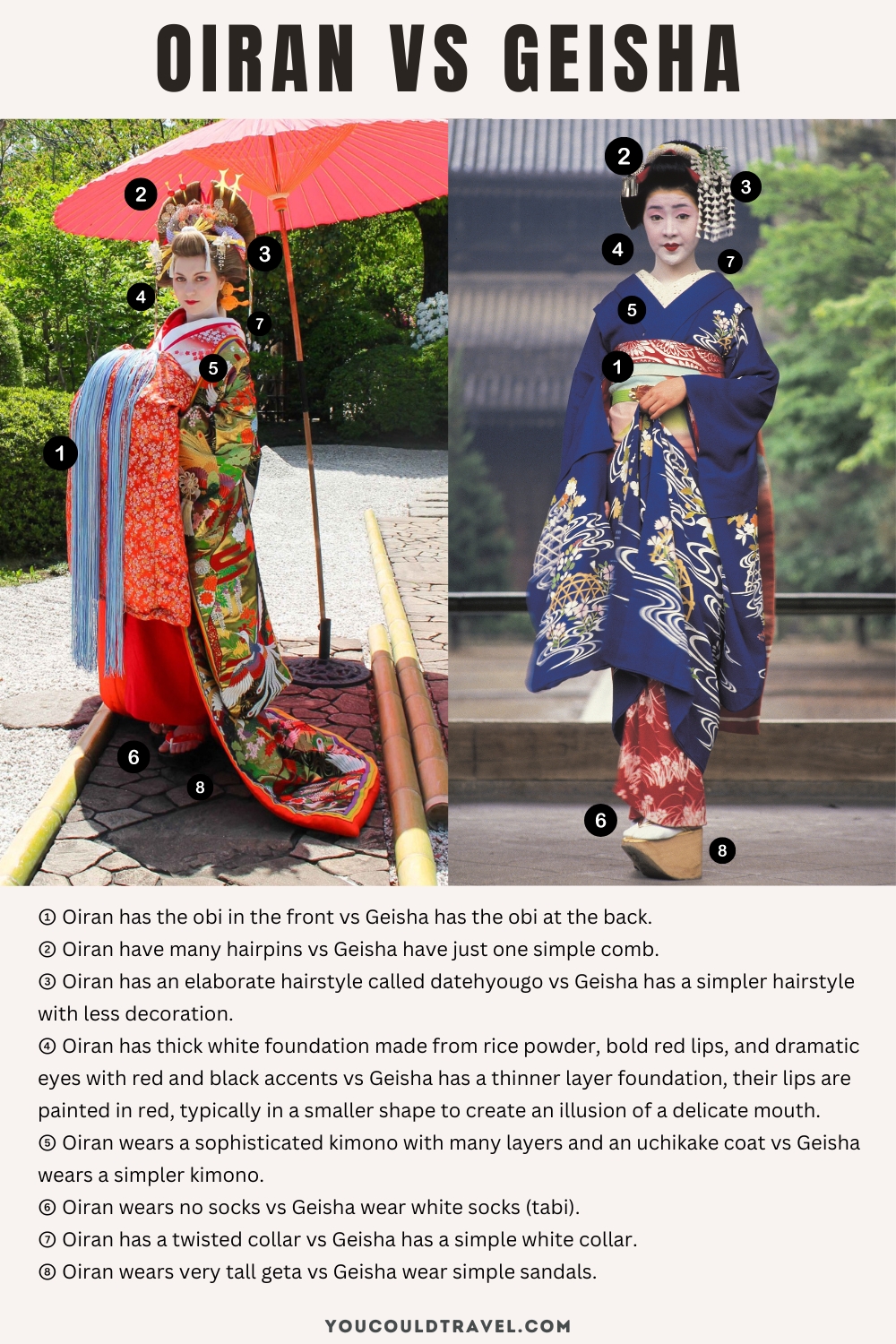
Oiran and geisha are both part of Japanese cultural history, but they have distinct roles and characteristics. Here are the top differences between oiran and geisha:
- Profession – Oiran were high-ranking courtesans who offered various entertainment services, including intimate services, to their elite clientele. Geisha, on the other hand, are professional entertainers who specialize in traditional Japanese arts, such as music, dance, and conversation, but do not engage in intimate services.
- Historical context – Oiran flourished during the Edo period (1603-1868) in Japan, particularly in the pleasure quarters of Yoshiwara in Edo (now Tokyo). Geisha emerged in the 18th century and gained prominence during the late Edo period, continuing to exist today.
- Appearance – Oiran were known for their extravagant and opulent attire, including elaborate hairstyles, heavy makeup, and multi-layered kimonos. Geisha typically wear simpler and more elegant kimonos, and their hairstyles and makeup are more understated in comparison.
- Training – Both oiran and geisha underwent rigorous and very difficult training, but their areas of focus were different. Oiran were trained in various forms of entertainment, including intimate arts, while geisha focused on mastering traditional Japanese arts, such as playing the shamisen, dancing, and tea ceremony.
- Social status – Oiran held a high social status and even ranking and were considered celebrities during the Edo period. In contrast, geisha were and continue to be respected for their artistic skills, but generally did not achieve the same level of fame and social status as oiran.
- Walking style – Oiran had a unique and slow walking style called the “oiran walk” or “soto-hachimonji” which involved taking small steps and swaying from side to side, accentuating the movement of their hips. Geisha do not have a specific walking style and typically walk in a more graceful and natural manner.
- Client interaction – Oiran entertain their clients in private settings, often behind closed doors, while geisha perform in more public settings, such as teahouses, banquets, and parties. Geisha are also known for their ability to engage in intelligent conversation, whereas oiran focused more on their physical appeal.
What is an Oiran
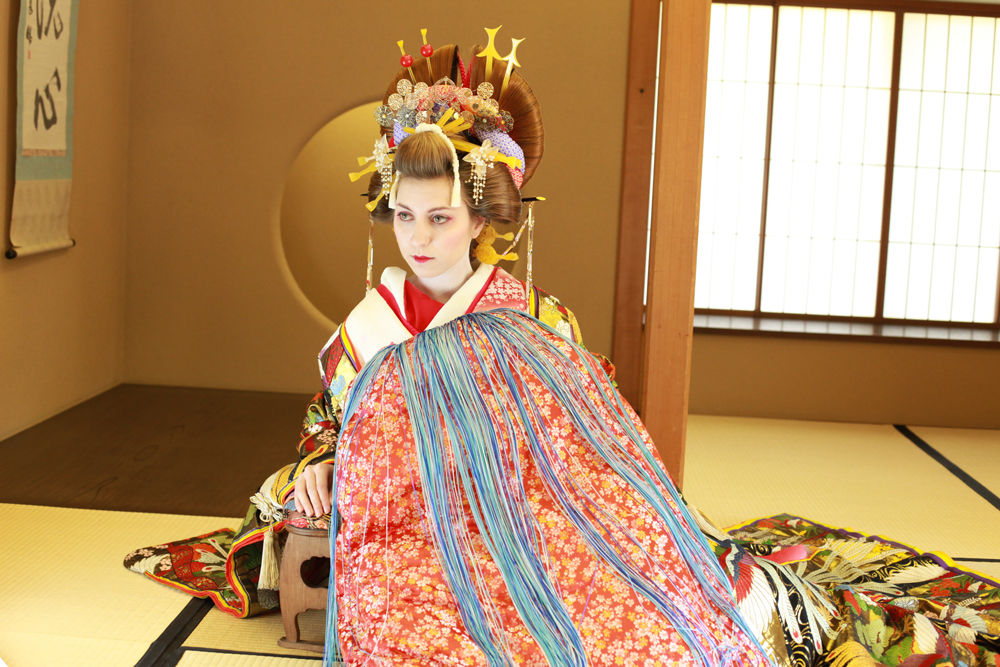
Oirans, also known as Tayū, were prominent high ranking graceful Japanese courtesan ladies who flourished between 1643 and 1763. These women, often referred to as yūjyo or “women of pleasure” were in a separate category from geishas, who sold their artistic skills rather than their bodies. Oirans held a significant role in the entertainment districts, working alongside geishas, but were distinguished by their status as known courtesans. The oiran profession gradually faded away after the Edo Period.
Despite their association with the world of pleasure, oirans enjoyed a remarkable level of prestige, with the government bestowing upon them the esteemed Senior Fifth Rank, a title comparable to that of a feudal lord. The symbolic red collar they adorned further emphasized their elevated status in society.
History of an oiran
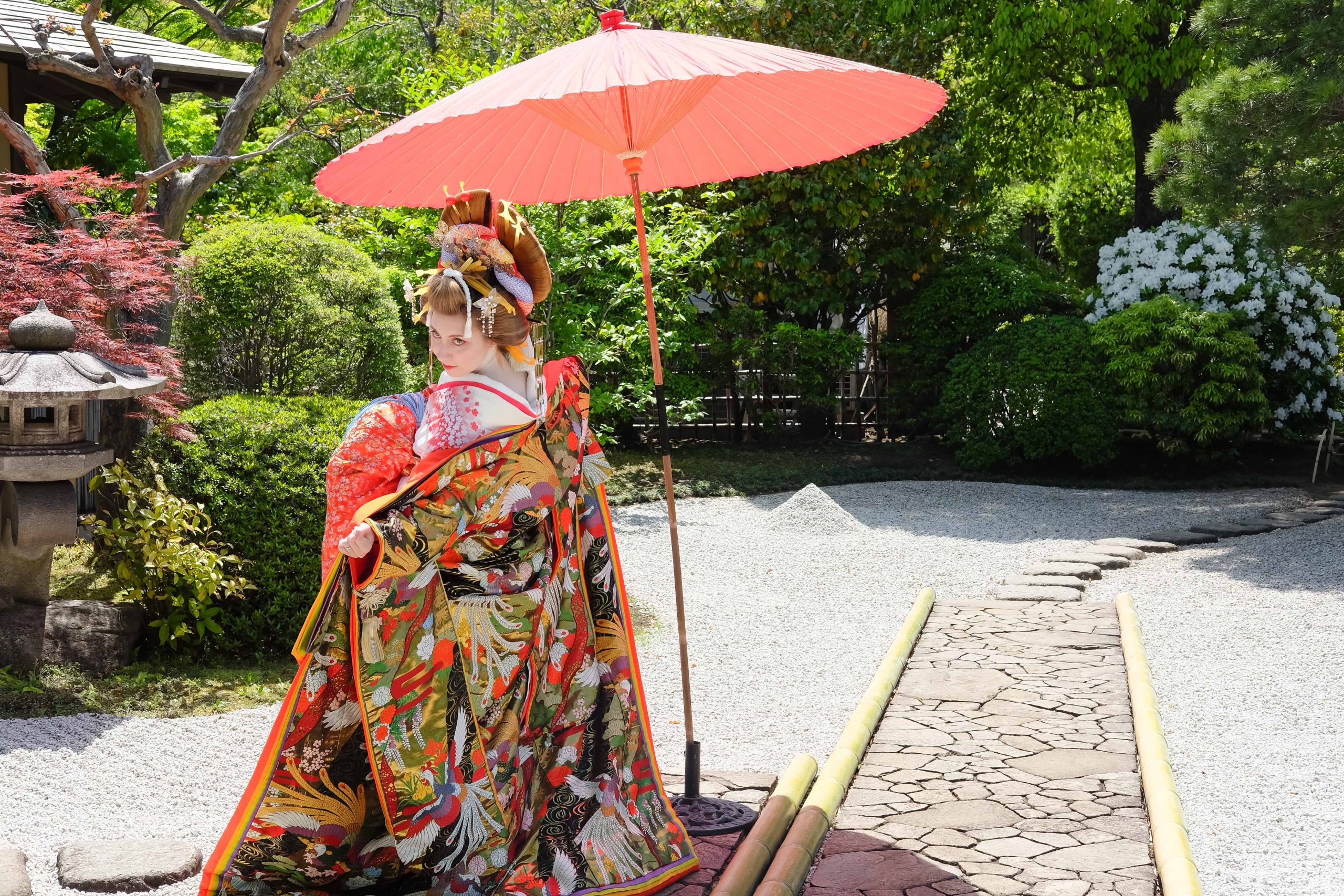
The profession of oiran arose in the early Edo period (1600–1868), following the introduction of laws restricting brothels to bounded pleasure quarters known as yūkaku which were literal walled-in districts.
There were three prominent red-light districts known in Japan: Yoshiwara, a renowned yūkaku in what is now Tokyo, Shimabara in Kyoto, and Shinmachi in Osaka.
The journey to becoming an oiran was often a harsh and involuntary one. Many young girls, hailing from impoverished farming and fishing communities, were sold by their families. Some were even kidnapped and forced into the profession. These unfortunate girls found themselves confined to a yūkaku.
Within the gates of these districts, escape was nearly impossible, as those who attempted to flee were hunted, captured, and brutally punished. The women were bought and sold for prices ranging from approximately 300,000 to 1.8 million yen. Only a select few ascended to the coveted status of oiran, while others were consigned to more menial roles or faced a daily struggle for survival.
Beginning their service as prostitutes around the age of 16 or 17, these women endured a decade-long period known as the “10 years of suffering death”. There were few avenues for leaving this harrowing life: repaying their debt, having someone else redeem their debt and future earnings, or succumbing to an untimely death. Many remained trapped in the house, unable to free themselves from the cycle of debt.
The most alluring women were groomed to become oiran, receiving extensive education in classical literature, Japanese poetry, calligraphy, tea ceremony, samisen, Japanese harp, and games like go and shogi.
Clients seeking an encounter with an oiran were expected to demonstrate their wealth and offer extravagant gifts. The process of engaging with an oiran was a complex ritual involving multiple meetings, during which the oiran assessed the client’s suitability. Only after the third meeting, and upon receiving a handsel, would an oiran consent to sleep with a client. Once engaged, the client was required to remain faithful or face substantial compensation fees.
Over time, the oiran lost their celebrity status in wider society and came to be seen as caged women unable to leave the pleasure districts. Their appearance had also not reflected changes in fashion, and they did not resemble the increasingly popular and cultivated aesthetics of the geisha. The entertainment that oiran had mostly remained unchanged since generations of courtesans before them, while geisha were more adaptable and played contemporary tunes composed for the shamisen (three-stringed traditional Japanese musical instrument).
Hairstyle of an oiran
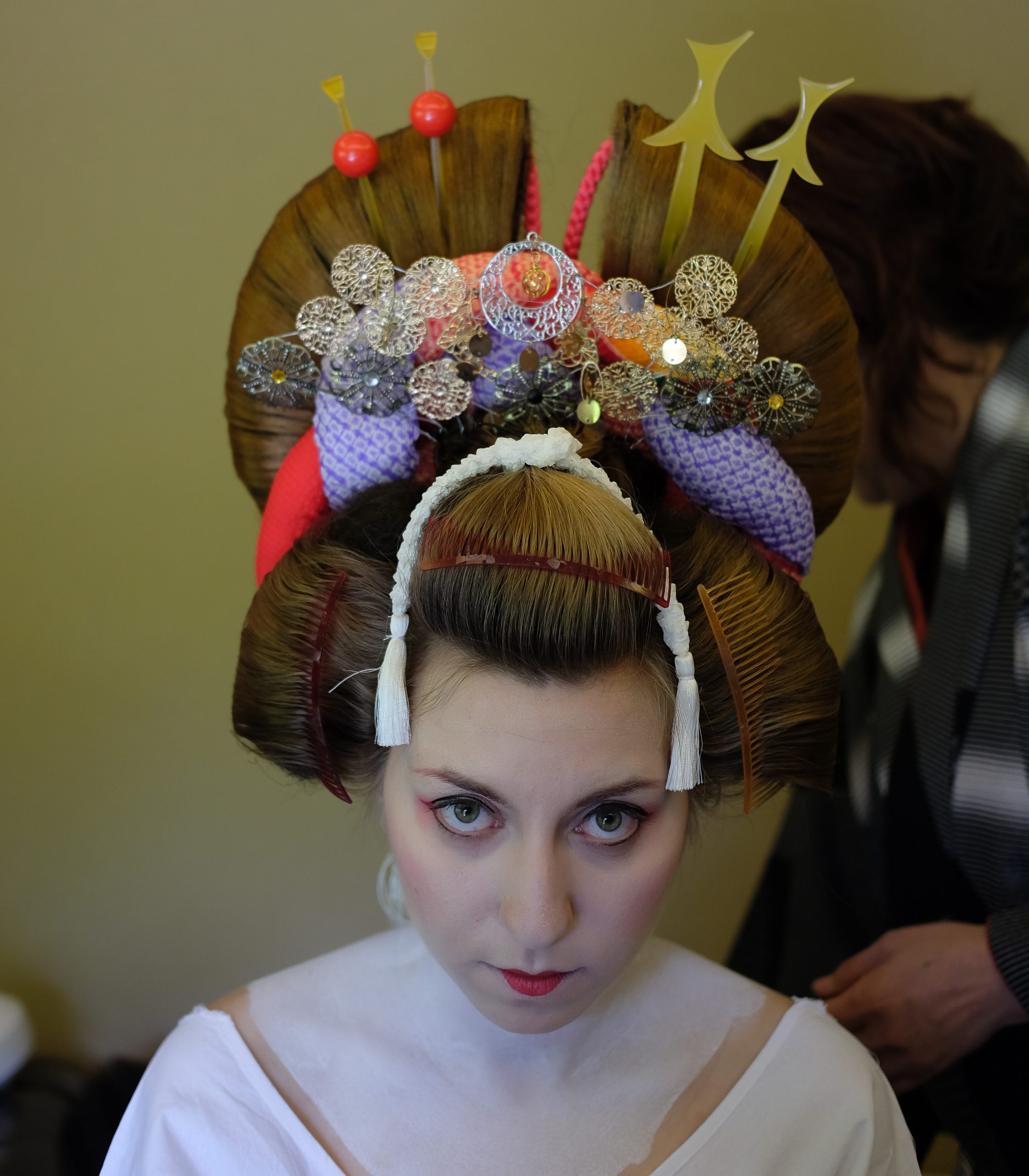
The hairstyle of the oiran is called the datehyougo which means butterfly hairstyle.
An Oiral would wear stunning ornaments made from materials such as tortoiseshell, silver, gold, and gemstones. Oiran would wear upwards of eight large kanzashi in their elaborate and heavily waxed hairstyles. The hair of an oiran could weight up to 10 kilograms.
Clothing of an oiran
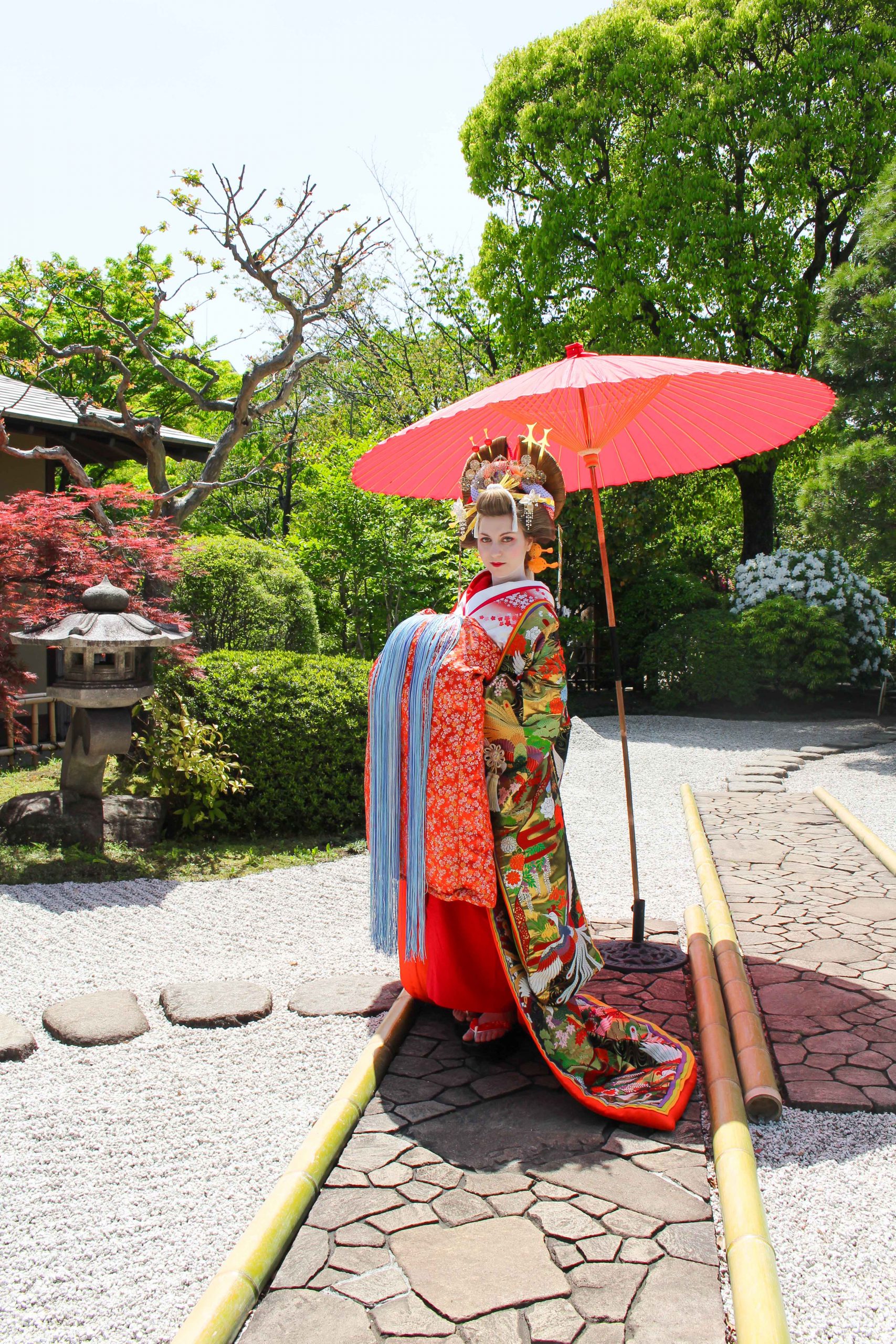
In total, a formal parade outfit worn by an oiran could weigh in excess of 20 kg and would require great assistance to put on. Oiran’s outfits were markedly different from those of geisha and the average woman, reflecting the upper-class tastes and expectations of their customers.
Here’s a list of the clothing items that an oiran would wear, along with an explanation of each:
- Kimono – An oiran’s outfit consists of multiple layered kimono. The outermost kimono would typically be a heavily decorated silk coat known as the uchikake, which would feature a heavily padded hem. The underkimono featured a patterned design only on the lower skirt and resembled a juban (part of kimono underwear).
- Obi – The oiran kimono was belted with an obi tied at the front. The obi was both wide and stiff. Oiran became known for wearing a specific style of obi known as the manaita obi, which was highly decorative.
- Oiran geta – Pauwlonia wood clogs that were 20 cm tall and had three “teeth”. Oiran would not wear tabi socks, and the bare feet were considered to be erotic in Japan.
Makeup of an oiran
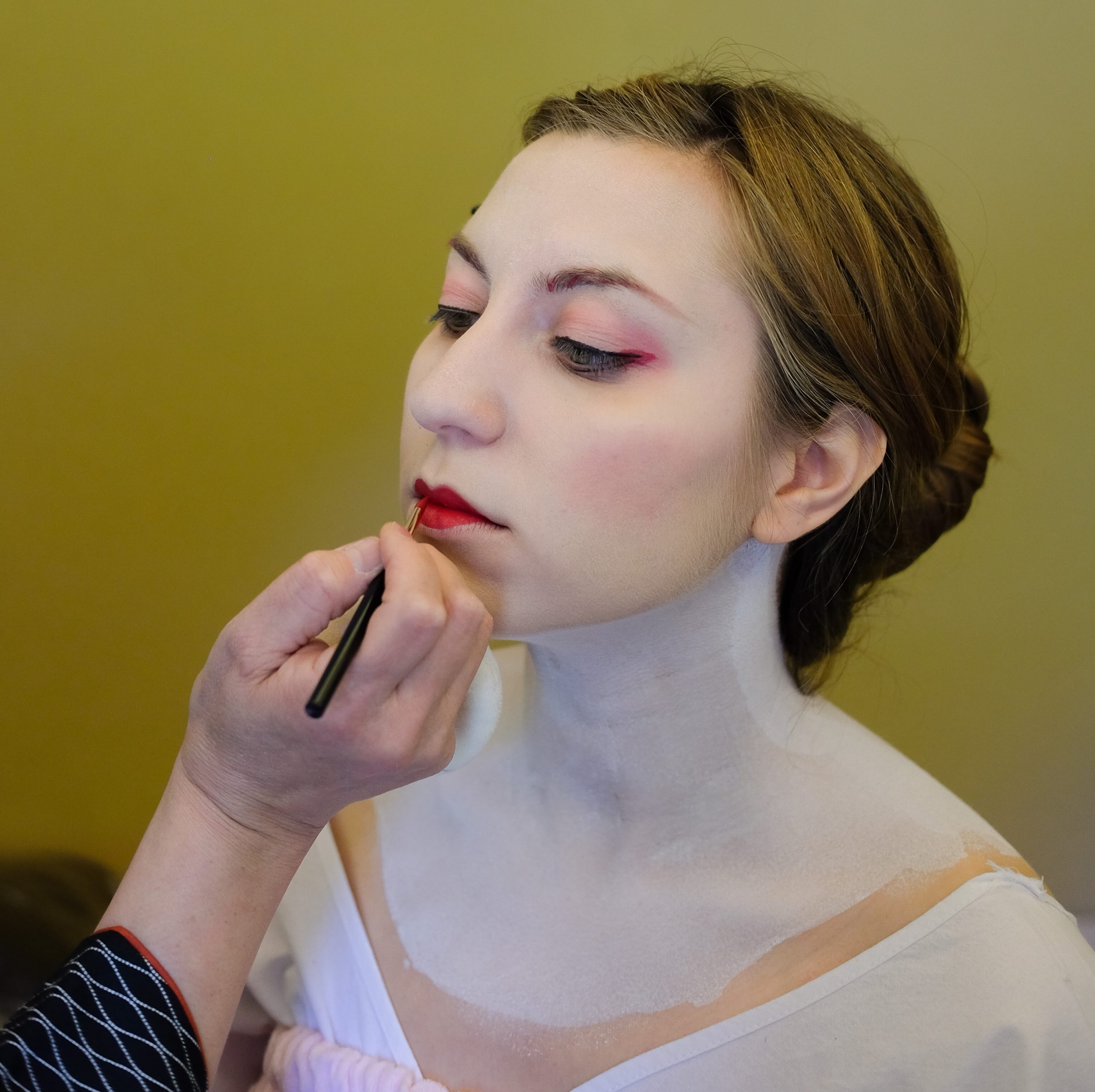
Oiran wore striking makeup, characterized by a thick white foundation made from rice powder, bold red lips, and dramatic eyes with red and black accents. Their eyebrows were elongated and shaped into a gentle curve.
At the back, the nape of the Oiran has two alluring stripes of bare skin exposed, which were considered alluring.
Oiran Ladies Walk (Oiran Dochu parades)
In present-day Japan, a few tayū and oiran re-enactors perform in traditional clothing, without engaging in prostitution. Some kimono and makeup houses in Japan also dress women in elaborate oiran costumes and stunning kimonos. This is one of the things I did on my trip to Tokyo.
The Bunsui Sakura Matsuri Oiran Dōchū is an annual event in Niigata Prefecture, featuring three women dressed as oiran with 70 accompanying servants. The Ōsu Street Performers’ Festival in Nagoya also features a procession of oiran through a shopping arcade, attracting thousands of spectators. Another oiran dōchū parade is held in the Minamishinagawa district near Aomono-Yokochō, Shinagawa every September. These events are popular and highly sought after by those wishing to participate in the parades.
What is a Geisha
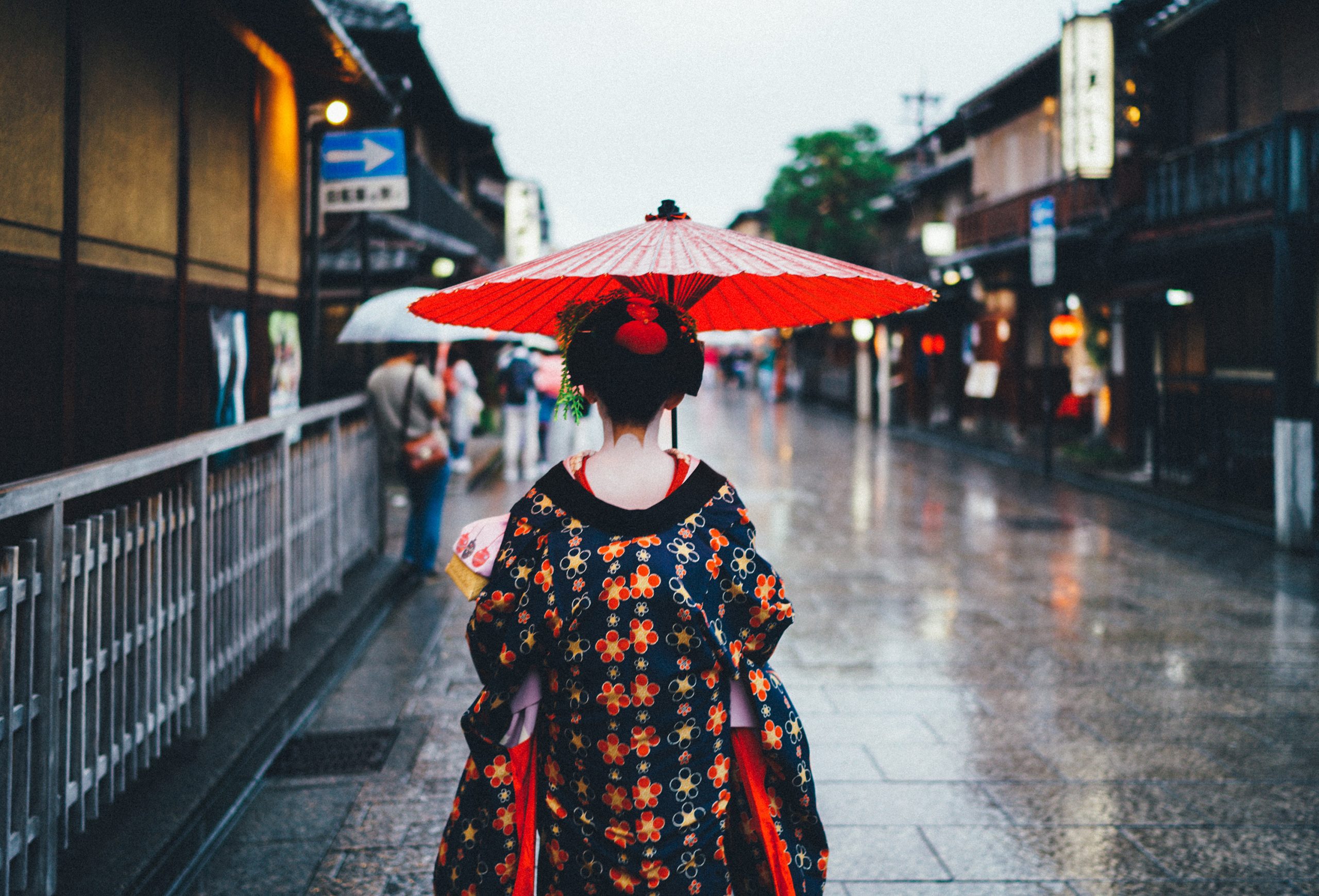
Geisha, a term meaning “art person” or “artisan” are highly skilled Japanese female entertainers known for their distinctive appearance and extensive training in various traditional Japanese arts.
Geishas emerged in the 18th century, and are an integral part of Japan’s rich cultural history and have long been admired for their grace, refinement, and dedication to their crafts.
Contrary to some misconceptions, geisha are not courtesans or involved in any form of intimate service. Geishas are professionals who dedicate their lives to mastering and preserving the traditional arts of Japan, such as music, dance, and conversation. Geisha undergo rigorous training and apprenticeships to hone their skills and become experts in artistic disciplines.
Dressed in exquisite kimonos and with their faces adorned in the classic white makeup, geisha captivate their audiences with performances that embody the beauty and elegance of traditional Japanese culture. Geishas still exist today, and you can mainly see them in Asakusa, Tokyo or Gion, Kyoto.
History of the Geisha
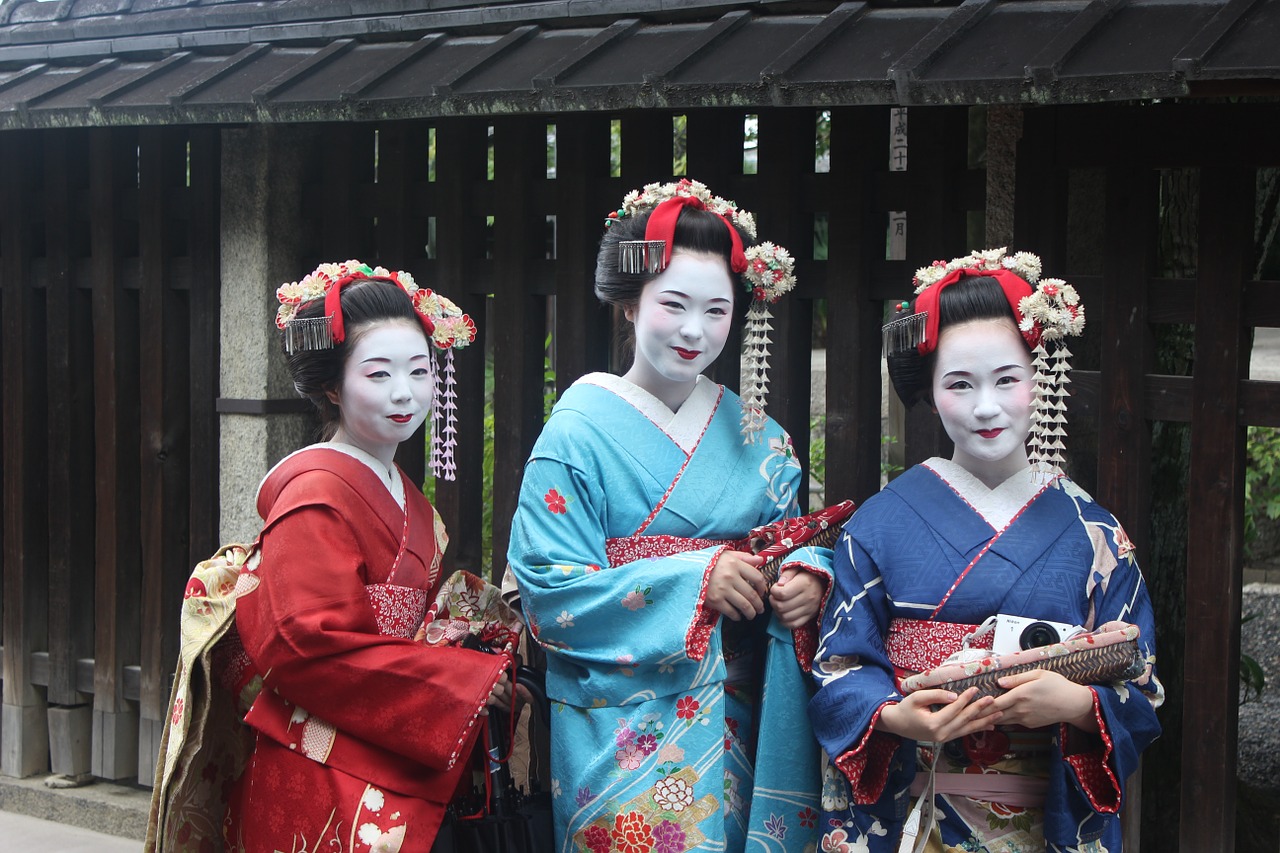
Geisha emerged in the 18th century in Japan, who provided song and dance entertainment for clients of pleasure quarters. The first female geisha was a skilled singer and shamisen player called Kikuya, and by the early 18th century, female geisha were well-known for their talents as entertainers.
Geisha were established as an independent profession in its own right. To not compete with Oirans, Geishas were prohibited from selling their bodies and wearing flashy hairpins or kimonos, which were associated with higher-ranked courtesans.
Despite their official status as lower-class entertainers, geisha grew in popularity, particularly among emerging merchant classes who were unable to access courtesans.
By the 1830s, geisha were considered the premiere fashion and style icons in Japanese society, and many fashion trends started by geisha became widely popular.
Courtesans no longer held celebrity status by the end of the 19th century, and with the criminalization of prostitution in Japan in 1956, the status of a geisha became even more celebrated.
The geisha profession underwent significant changes during and after World War II. Many geisha were conscripted into the war effort, and after the war, they returned to the traditional arts and abandoned Western-style appearances and entertainment. The Prostitution Prevention Law in 1956 led to the official criminalization of practices such as mizuage.
Today, geisha mostly still live in okiya (Geisha houses) and are hired to attend parties and gatherings. The number of geisha has declined over time, but the profession still attracts recruits set up by okiya.
Different types of Geisha
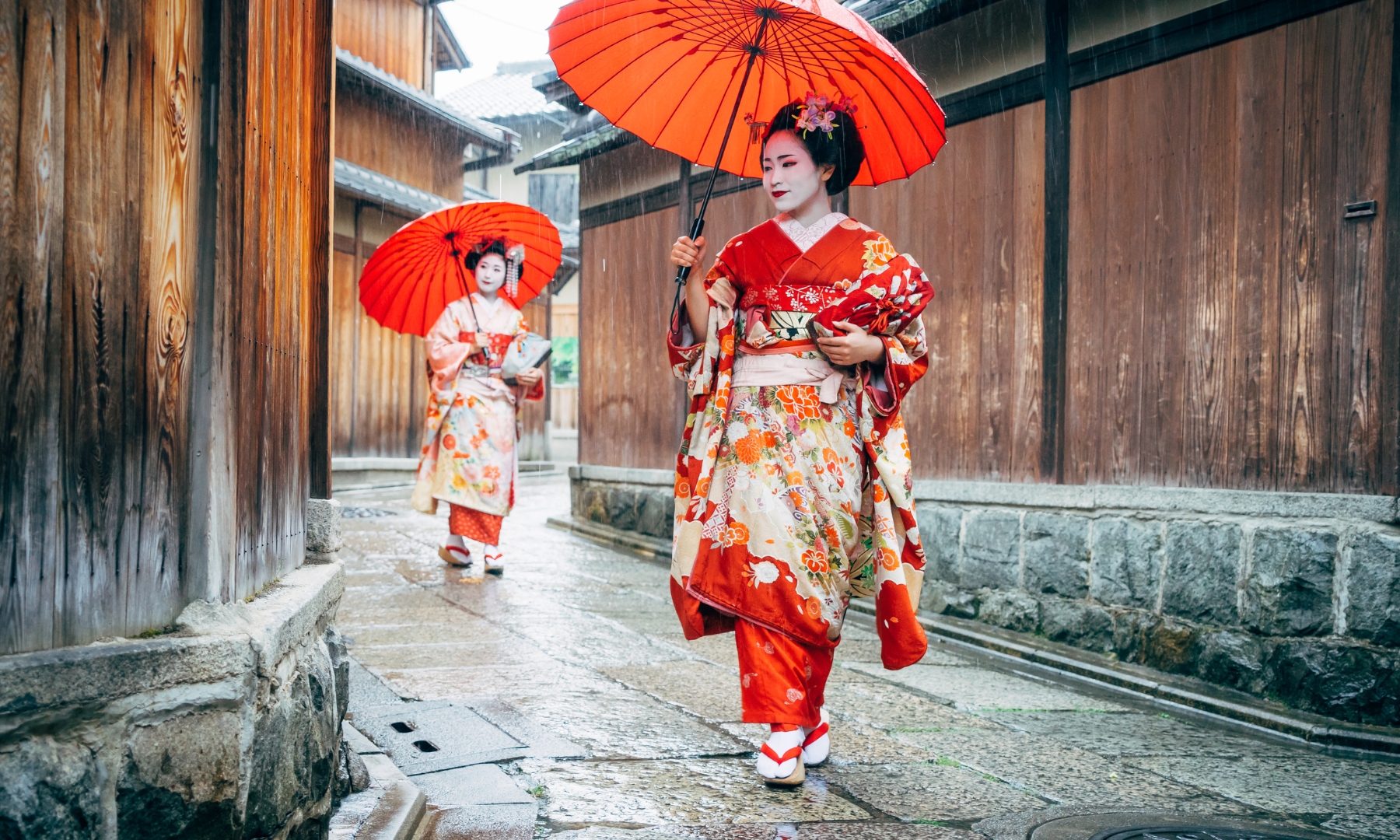
In modern times, there are three main types of geisha, each distinguished by their style of dress, training, and the area where they perform:
- Geiko – This term refers to geisha from Western Japan, mainly Kyoto and Kanazawa. Geiko usually wear more subdued kimonos, with simpler hairstyles and makeup.
- Maiko: These are apprentice geisha, typically in their teenage years, who are training to become fully-fledged geisha. Maiko wear more colourful and elaborate kimonos, with more intricate hairstyles and heavier makeup.
- Okiya Geisha – These are geisha who live and work exclusively within their okiya (geisha lodging house), entertaining guests in teahouses or restaurants. They do not perform at public events or parties like geiko and maiko, but rather cater to a select clientele.
Hairstyle of a Geisha
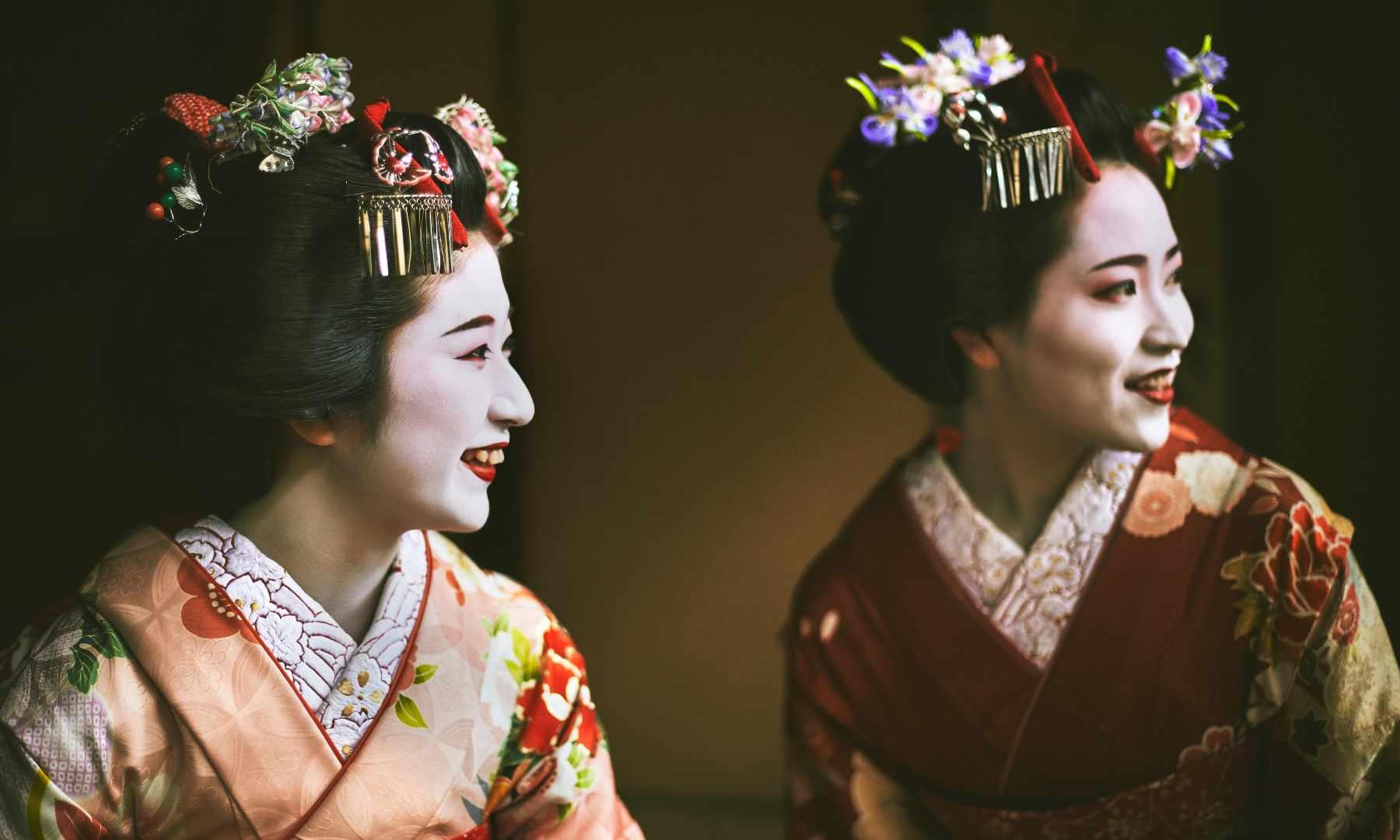
The shimada hairstyle, developed in the 17th century, became the basis for geisha and maiko hairstyles.
Maiko wear five different hairstyles, marking different stages of their apprenticeship. Usually, the maiko will wear nihongami hairstyle with kanzashi hair ornaments.
Geisha wear a variety of the shimada hairstyle (chū taka shimada), typically shaped specifically for their face by a wig stylist.
Both maiko and geisha hairstyles are decorated with hair combs and hairpins (kanzashi). A maiko will wear more kanzashi than a geisha. In fact, one of the easiest ways to discern between a Geisha and a Maiko is how elaborate and decorated their hair is.
Clothing of a Geisha
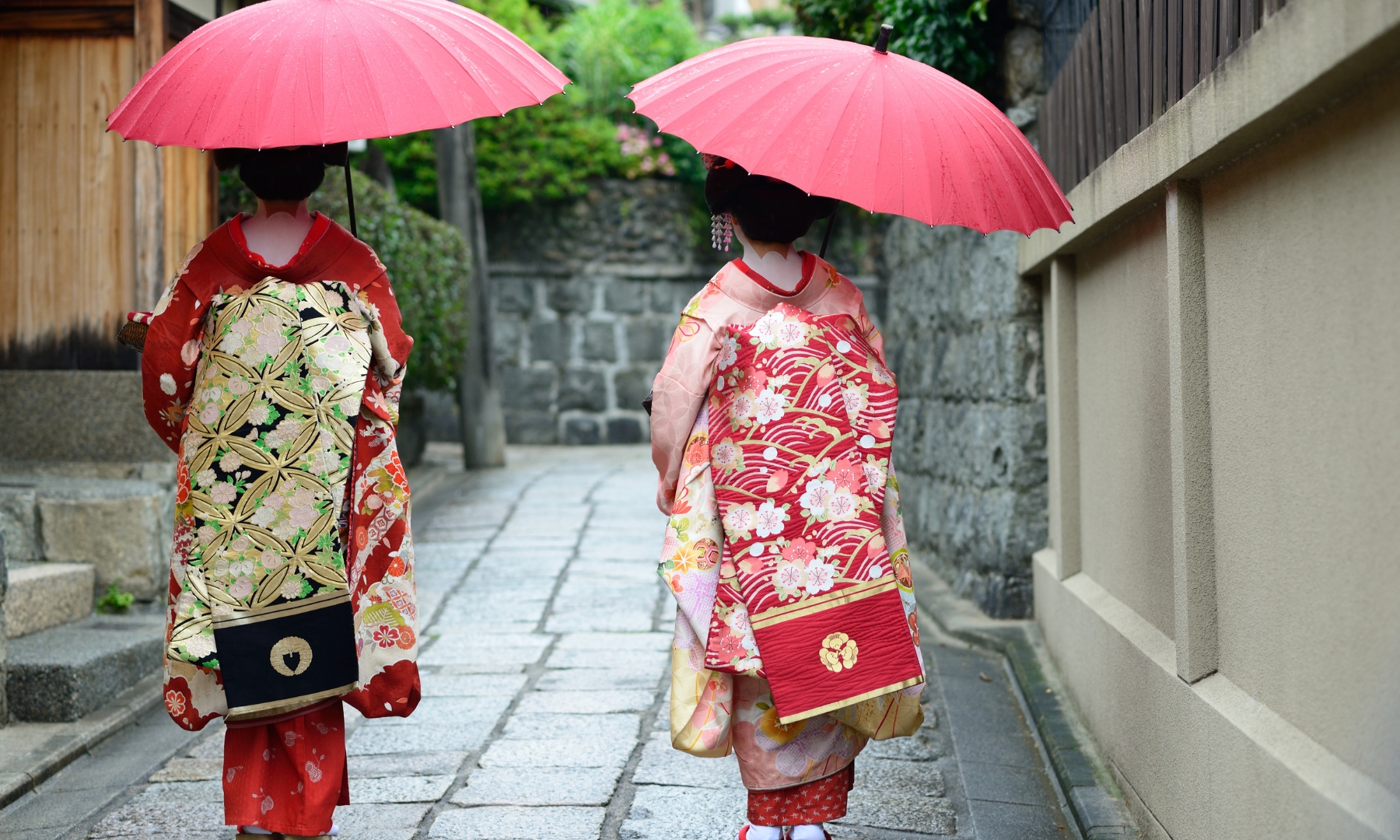
Geisha and Maiko wear kimono while working, and the type of kimono varies based on age, occasion, region, and season.
Both geisha and apprentice geisha typically wear kimono known as hikizuri, which have extra-long trailing skirts, and feature a collar set further back into the neck.
Maiko wear hikizuri with furisode-style sleeves, which are tuck sewn into either sleeve and each shoulder. Apprentices wear long, formal obi, and zori or okobo with their kimono.
Geisha wear kimono more subdued in pattern and colour than both regular women’s kimono and the kimono worn by apprentice geisha. They exclusively wear solid white han-eri and wear either geta or zōri when wearing a kimono.
Geisha wear their obi in the nijuudaiko musubi style (drum knot) tied with a fukuro obi. Geisha from Tokyo and Kanazawa also wear their obi in the yanagi musubi (willow knot) style and the tsunodashi musubi style.
Makeup of a Geisha
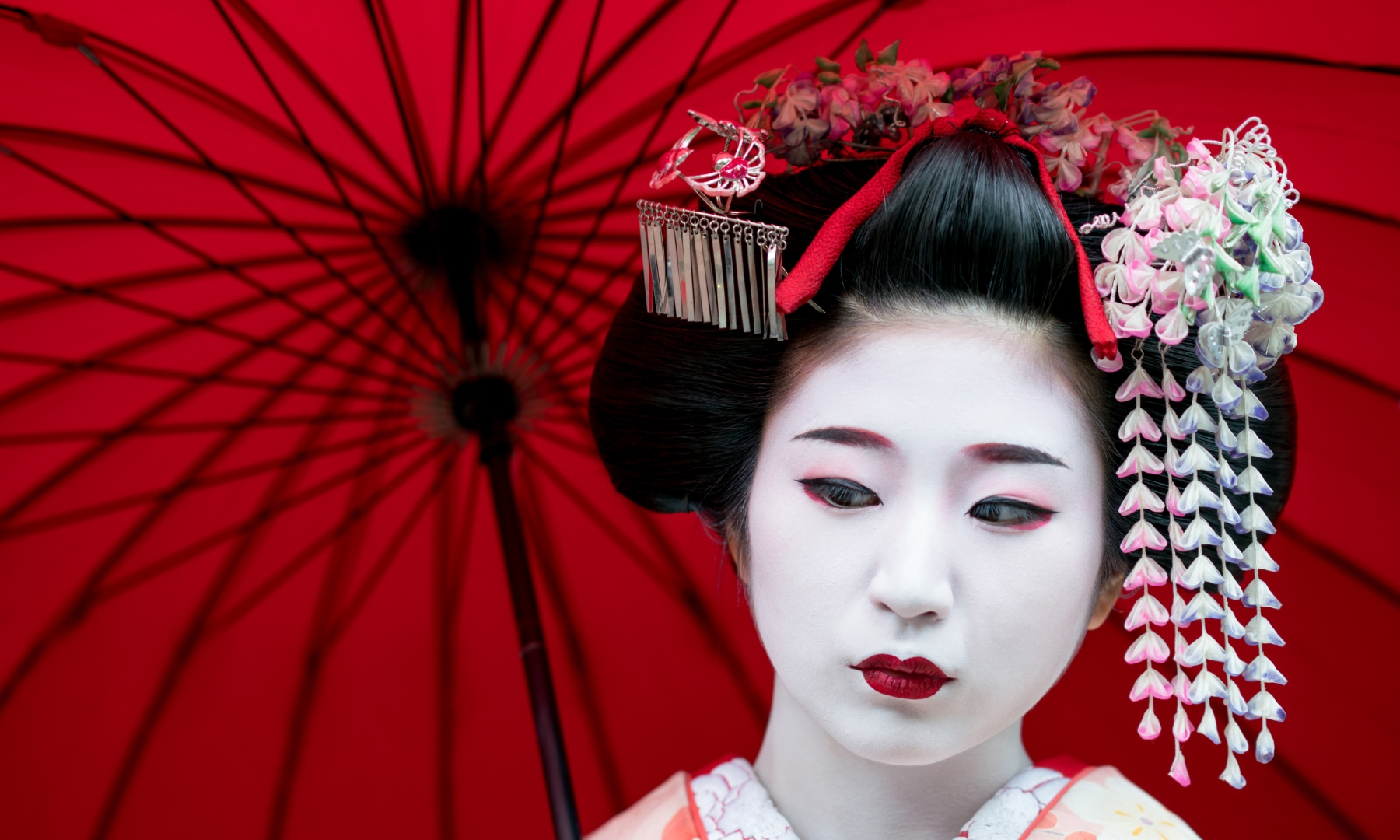
Maiko and geisha wear traditional white foundation known as oshiroi, along with red and black eye and eyebrow makeup, red lips and light pink blusher.
Both maiko and geisha use a red lipstick called beni to underpaint their lips.
Geisha tend to wear heavier eye and eyebrow makeup compared to maiko, and usually only wear full white makeup on special occasions or when performing on stage.
Final Thoughts
Both Oiran and Geisha were and continue to be highly admired for their role played in Japanese culture, it is obvious that there are crucial differences between the two professions. While Oiran no longer exist because of the strict prostitution laws in Japan, Geishas continue to perform and showcase their artistic skills.
Few Oiran re-enactors exist nowadays, and some kimono and make up houses offer the possibility to dress up as an oiran and do a photoshoot for keepsakes. Geishas, while still sought after and revered by both Japanese people and tourists to Japan, their numbers declined over time.
Professional, historical context, appearance, all showcase that there is a clear difference between Oiran and Geisha. While very different indeed, both enigmatic figures continue to make people all over want to visit Japan next.
Frequently Asked Questions
Is oiran higher than geisha?
Yes, oiran were considered to be of a higher status than geisha, but they served different roles in Japanese society. Oiran ranking within the pleasure quarters was based on a strict hierarchy, and their status was sometimes equivalent to that of a fifth-ranking samurai, which put them on par with some feudal lords.
Oiran were skilled in various arts such as music, dance, poetry, and calligraphy, and were also trained in the art of conversation. However, their primary role was to provide intimate services to their clients. Oiran held a high social status and were considered to be the pinnacle of the pleasure quarters.
Geisha, on the other hand, originated as skilled entertainers who performed various arts like music, dance, and poetry, but they did not sell their bodies. They evolved from the ranks of apprentice courtesans, eventually forming their own distinct profession. Geisha served as hostesses and entertainers at high-class banquets and social gatherings. While they held a respectable status in society, they were generally considered to be of a lower rank compared to oiran.
What does an oiran do?
Oiran were considered to be the most accomplished and elite women in the pleasure quarters, and they provided various services to their clients. Some of their primary roles and activities included:
Entertainment – Oiran were highly skilled in various traditional Japanese arts such as music, dance, poetry, and calligraphy. They entertained their clients by performing these arts and engaging in cultured conversation.
Intimate services – Unlike geisha, who were strictly entertainers, oiran also provided intimate services to their clients. They were highly trained in the art of lovemaking, which was considered an essential part of their profession.
Fashion and appearance – Oiran were known for their extravagant and intricate fashion, including elaborate hairstyles, makeup, and luxurious kimonos.
Oiran walks – Oiran participated in public walks known as “oiran dochu” which were organized as a way to showcase their beauty, elegance, and status. These are still held nowadays with Oiran re-enactors.
Are oiran still legal?
No, Oiran as a profession no longer exista in Japan today. The decline of the oiran began during the Meiji Restoration (1868-1912), as Japan started to modernize and adopt Western influences. The rise of Geisha, who were purely entertainers and did not provide intimate services, also contributed to the decline of oiran.
Prostitution was made illegal in Japan in 1956 with the enactment of the Anti-Prostitution Law. As oiran were primarily high-class courtesans who provided both entertainment and intimate services in exchange for money, their profession would be considered illegal under current Japanese law.
What is the difference between geisha and oiran clothing?
Oiran looked more oranate and luxurious with elaborate hair decoration and makeup. In contrast, a Geisha’s look was more subdued. Here are the main differences in clothing between an oiran and a geisha:
Kimono – Oiran wore highly ornate and luxurious kimonos, with intricate embroidery, bold patterns, and bright colours. The kimonos were made from expensive fabrics. Oiran also wore multiple layers of kimono. In contrast, geisha wear more subtle and elegant kimonos. While geisha kimonos are still made of high-quality silk and can feature beautiful patterns, they are generally less extravagant than oiran kimonos.
Obi – Oiran wore a large, ornate obi tied in a distinctive knot called the “taiko musubi” or “drum knot” at the front of their kimono. Geisha, on the other hand, wear their obi tied in various styles at the back of their kimono.
Hairstyles and hair ornaments – Oiran were known for their elaborate hairstyles, which were often adorned with numerous hair ornaments, combs, and pins. Geisha also have distinct hairstyles, but they are generally less elaborate than those of the oiran.
Footwear – Oiran wore tall wooden sandals called “koma-geta” which were very tall. Oiran wore no socks. Geisha wear wooden sandals and tabi socks.
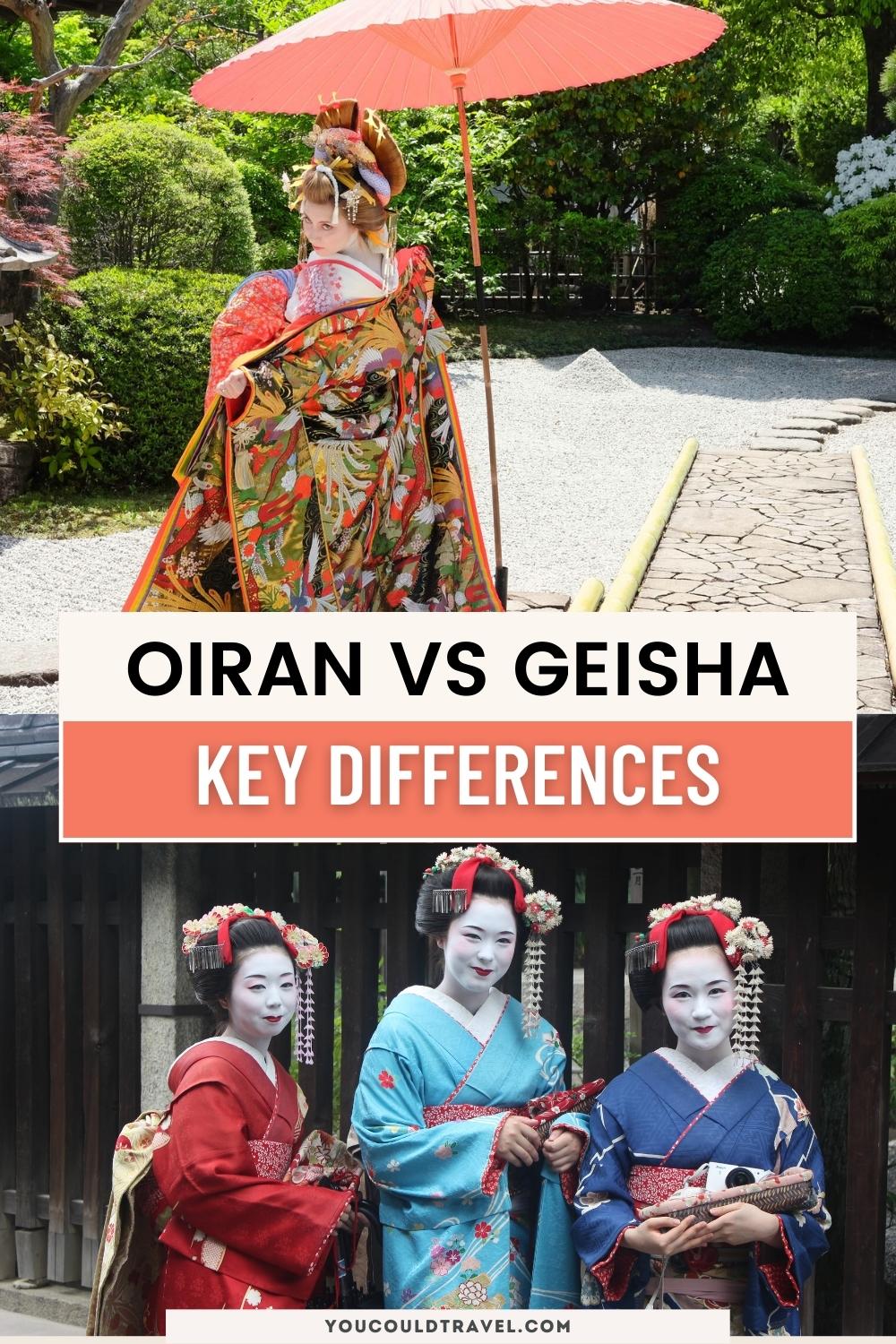
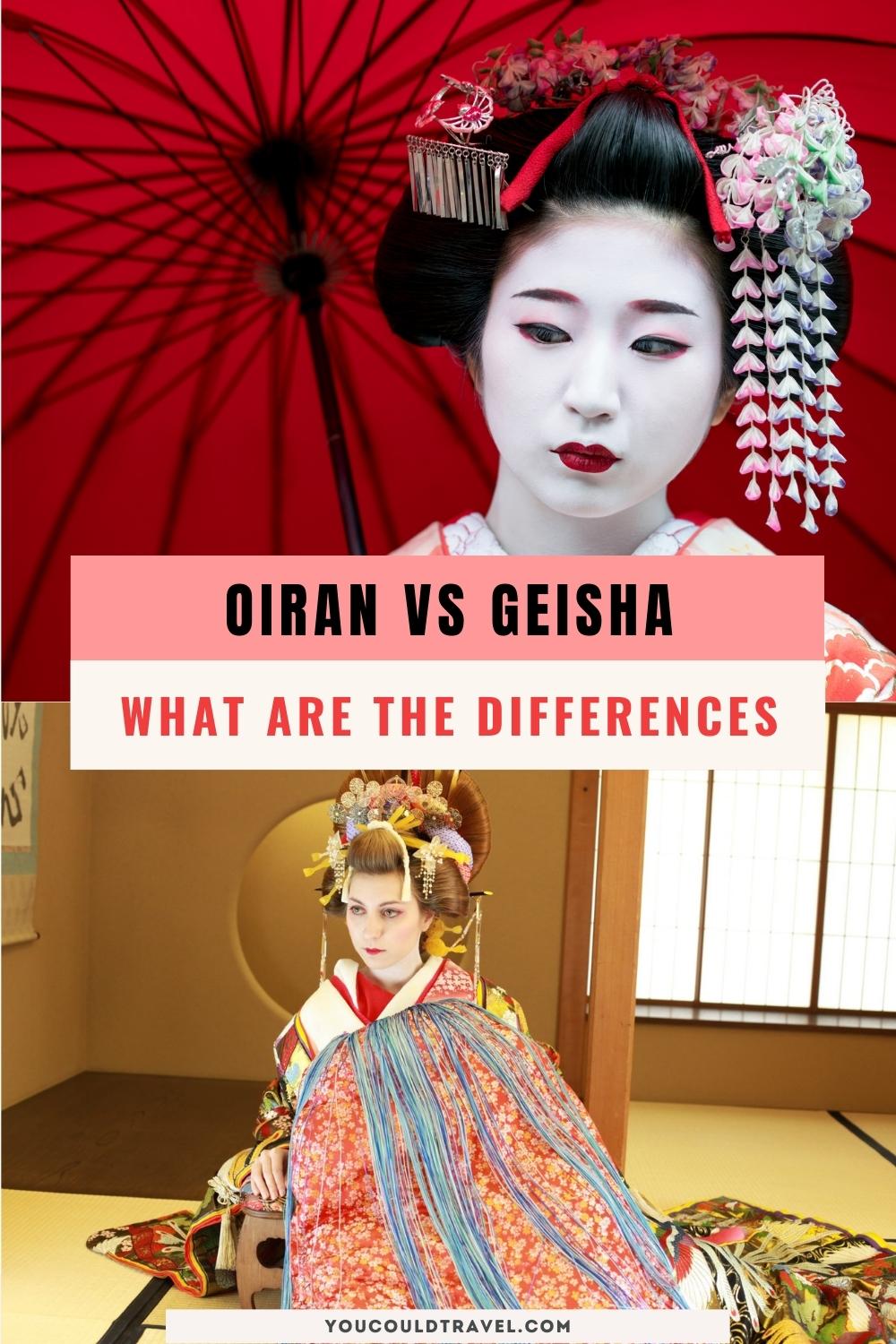

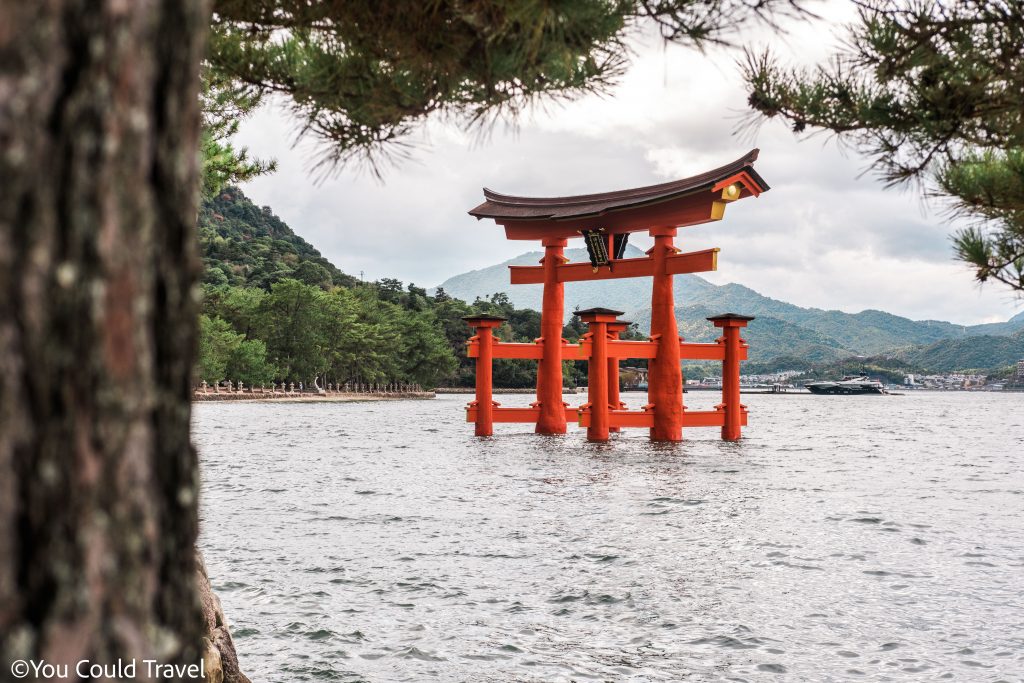
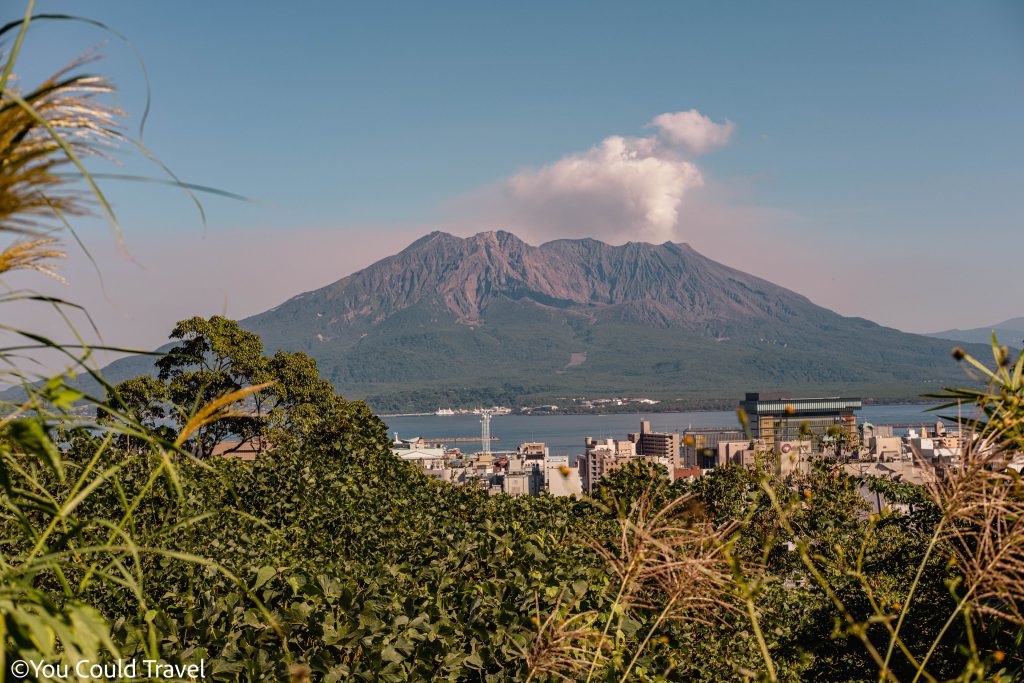
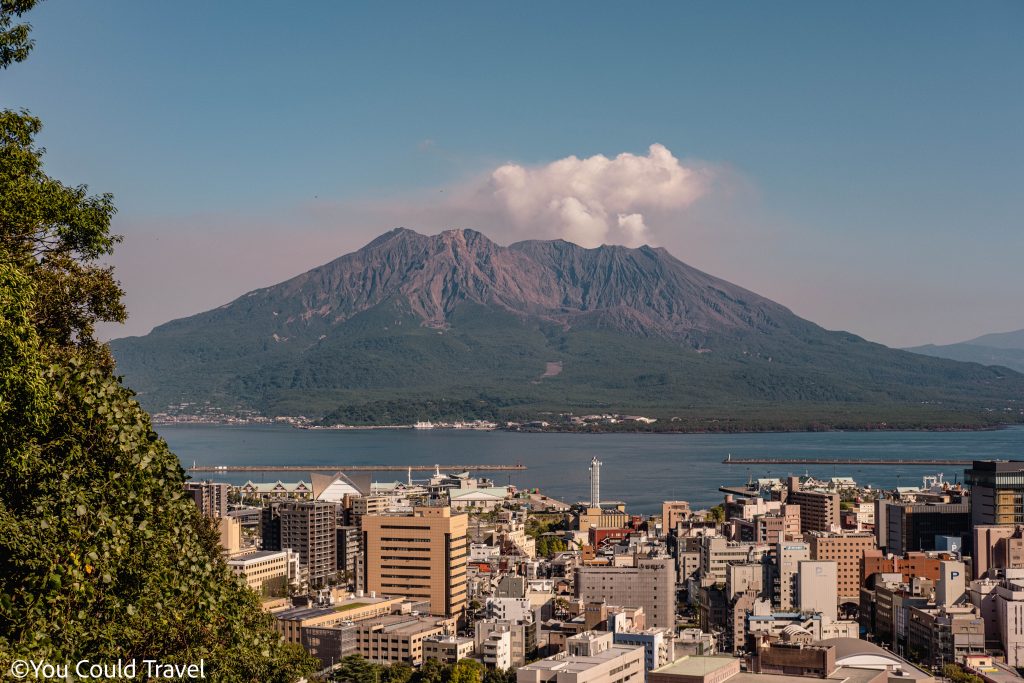
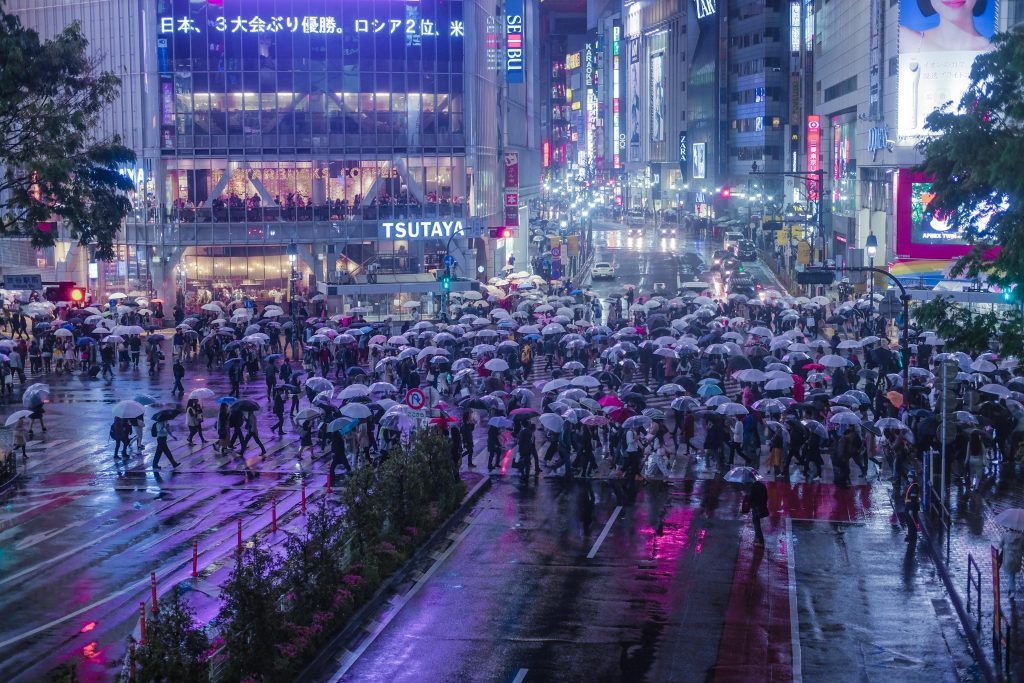
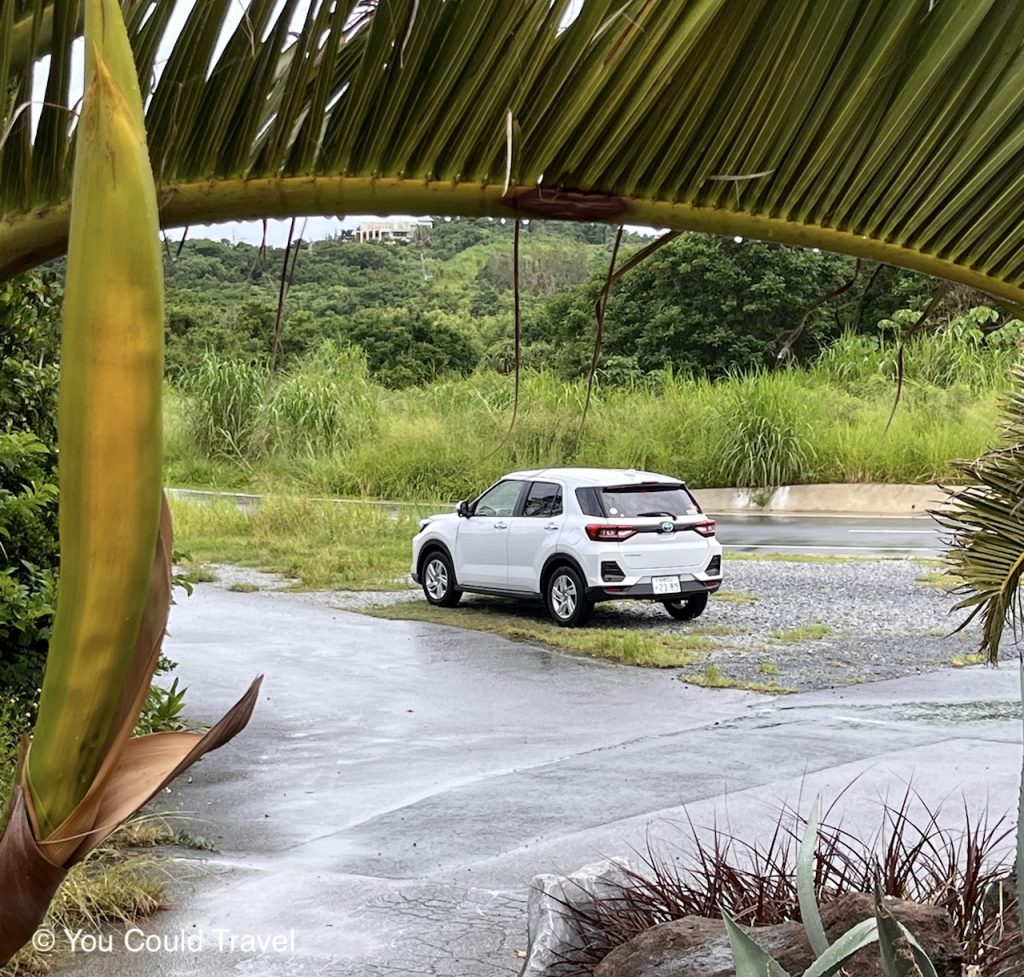



Leave a Reply